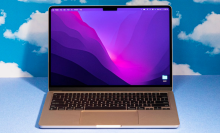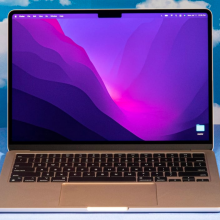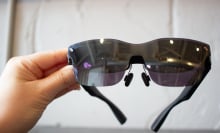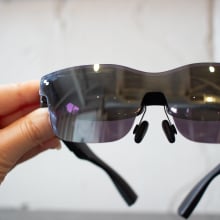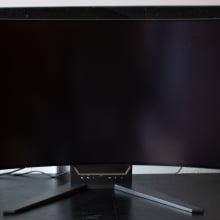When you think Garmin, a bathroom scale is probably not the first thing that comes to mind. But the tech company best known for its navigation systems and smartwatches does, in fact, make body weight scales (in addition to dog trackers, sonar systems, and a whole lot more).
The Index S2 smart scale, which runs $149.99, is Garmin’s latest and an update on the original Index smart scale. If you’re thinking about adding the Index S2 to your health tracking toolbox, consider these pros, cons, and defining features:
The first impression is a good one
At 12.6 inches x 12.2 inches x 1.1 inches and 4.4 pounds, the Index S2 is pretty standard, size- and weight-wise, but it looks and feels like a quality scale. Whether you go for the black or white model, it has curved corners, a reflective surface (that smudges, but not a ton), and four feet built into the bottom to prevent slippage. Although a hard, flat surface is ideal, if carpet is your only choice, the box includes four risers that you can attach to each foot for maximal accuracy.
The ease of the setup process is another early plus of the Index S2. Once you download the Garmin Connect app, which I’m willing to bet most purchasers of this scale already have, all you have to do is insert the four included AAA batteries, add the device in the app, follow a few prompts, and customize your widget views (or stick with the default settings).
The WiFi connectivity is a perk
Having tested both Bluetooth- and WiFi-equipped scales, I’m definitely a fan of the latter. The main reason is convenience: When a scale and its companion app are connected via WiFi, you don’t have to have your phone on hand and the app open while weighing yourself in order for your metrics to track. That the Index S2 relies on WiFi is another tick in the pros column.
The display is crisp but cluttered
Of the handful of smart scales I’ve tested, the Index S2 has the highest-quality display. The information it presents is bold, bright, crisp, and — rare among scales — multicolored, creating a surprisingly pleasant viewing experience from above.
On a less positive note, for the size of the screen, there’s a lot going on. Key numbers like weight and BMI definitely take center stage when it’s their turn to scroll through, but the top portion of the screen packs in superfluous information such as the date and time, WiFi strength, battery level, and symbols for each metric (like a flexed bicep for muscle mass). The result is more clutter than is necessary for a body weight scale.

The weighing process is a little slow
Weighing yourself on the Index S2 is not as simple as stepping on and seeing your weight pop up. Like scales of the past, you have to tap it and wait for the display to activate before you’re supposed to step on and let your weight register. Once your initials pop up, signifying that you’ve been identified, you can step off and watch your various measurements scroll through.
That’s the idea, anyways. The scale was pretty finicky for both my husband and me, sometimes responding to a single foot tap, and other times requiring three or four attempts to get the display to light up. Even once it does, the process feels a little slow, as you wait for your weight to lock in and then initials to blink a few times before the scrolling begins. (You do see your weight right when you step up, but there’s a decent lag between that and the rest of your measurements.)
The scale offers a wealth of information
The Index S2 tagline — “It’s not just about what you weigh” — speaks to the wealth of information that the scale offers users beyond their real-time weight. It also measures body mass index (BMI), body fat percentage, skeletal muscle mass, bone mass, and body water percentage, as well as shows your 30-day weight trend. Whether you choose to track all of those metrics or just your weight is up to you, and easily customized in the app.
…but the accuracy is questionable
Another message prominently displayed in the overview tab of the Index S2 webpage is, “Accuracy matters when it comes to your goals.” But how accurate the scale actually is is up in the air, with no explanation offered about the technology it relies on, what (if any) weight performance tests it has been subjected to, or the general limitations of at-home scales such as this one. Without that information, a certain amount of skepticism is warranted.
The Garmin Connect app serves as a weight log, but not much more
Some smart scales present limited information themselves, while their companion apps offer a deeper dive into the numbers. That’s not how the Index S2 works. The scale and the app show the exact same things, with the exception of the app’s seven-day, four-week, and one-year trend graphs. In other words, the app doesn’t offer much beyond serving as a log for past weigh-ins. Some users might consider minimal interaction with the app a plus, while others may crave more information than what the scale shows them in real-time.
It accommodates 16 users
When it comes to multiple user accommodation, the Index S2 outshines most smart scales with a capacity of 16 people. (By contrast, the Fitbit Aria Air and Withings Body+, which I reviewed recently, can each track up to eight users.) Each new user has to have a Garmin Connect account and be a connection to the owner of the scale, which can quickly be done in the app.
To see how well the multiple user feature works, I tested it out with my husband, who was already one of my Garmin connections. Since he already had Garmin Connect on his phone, setting him up was as simple as sending him an invitation through the app (Garmin Devices → Index S2 → Manage Users → Invite People). Once he accepted the invite and answered a few questions, the scale started to recognize him and sync his data. It’s unsurprising that the scale consistently detected who was who between the two of us, given that there’s about a 60-pound difference between our weights, but I’d be interested to see how well it differentiates between more similarly-sized users.
The emphasis on multiple daily weigh-ins sends the wrong message
One of the perks of the Index S2, according to Garmin, is its capacity for multiple weigh-ins, which give you the ability to “track how your body changes throughout the day.” In my opinion, that’s not a great message to send. First of all, your weight fluctuates all day long, depending on your food and water intake, sweat loss, urination, and other factors. That’s why the rule of thumb for weight tracking is to weigh yourself under the same circumstances and at the same time each day.
Second of all, is weighing yourself more than once a day even a healthy habit to promote? From my perspective, that seems like a fast track to full-on weight fixation or worse.
Go for the Garmin?
The Garmin Index S2 scale, which retails for $149.99, is one of the pricier at-home scales on the market. While there are plenty of things to like about it — the color display, WiFi connectivity, array of measurements, and 16-user capacity, to name just a few — its subpar performance, in the end, does not justify the price tag. My biggest complaint involves the weighing process, which should be quick and painless. Instead, it was often slow and frustrating, my first few toe taps failing to activate the display and the data taking longer than should be necessary to scroll through. That the numbers it spits out may or may not be accurate only detracts from the experience even more.
Unless you’re a devoted Garmin user who wants to streamline your fitness and weight records in the Garmin Connect app, the Index S2 is not a great bang for your buck. Personally, I’d go for a cheaper scale while trusting Garmin to do what Garmin does best (GPS watches and navigation systems).
Topics Reviews Fitness Tech









